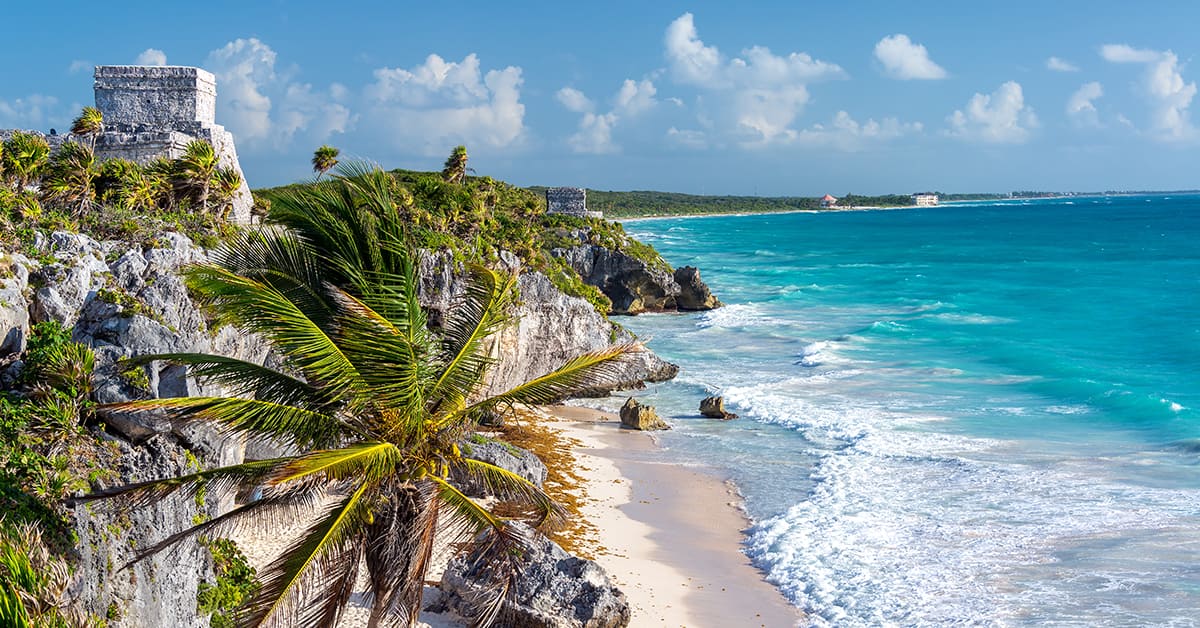Central American and Caribbean getaways provide a much-needed financial boost to the region, but geopolitical issues and a looming recession may stymie recovery efforts.

Carlos Gonzalez Fillad, a managing director at HSBC Group, was recently on vacation in Mahahual, Mexico. While there, he chatted with a few local scuba diving instructors and received a bit of positive news: Tourists are coming back.
“They are seeing a return of activity, little by little,” he says. “The cruise lines are active again.”
That’s good news because tourism is “critical” for the economies of Central America and the Caribbean, he adds. Mahahual, a somewhat remote village slightly less than two miles from the Costa Maya cruise port, suffered when borders closed during the Covid-19 pandemic—as did the rest of the region.
Travel and tourism GDP for the Caribbean and Latin America in 2020 dropped by 58% and 41.1%, respectively. Extreme poverty throughout the entire region escalated from 13.1% of the population in 2020 to 13.8% in 2021. That is a 27-year setback, according to the UN.
The situation worsened on the heels of the global health crisis and a poor vaccine rollout. Geopolitical factors, such as Russia’s war in Ukraine, and the effect of higher commodity prices, were felt throughout the region.
Despite Latin America’s post-pandemic rebound, “the winds are shifting as global financial conditions are tightening and commodity prices are reversing their upward trend, while inflationary pressures persist,” according to the authors of an International Monetary Fund (IMF) blog post published in July.
But there’s a silver lining: Vacation-starved visitors from the US and Europe are making up for lost time and bringing a much-needed boost to local economies. Even though geopolitical issues are getting in the way of a full-fledged recovery to pre-pandemic levels, current consumer spending habits indicate that tourism is returning.
Credit card giant Visa recently reported that the US economy has an estimated $300 billion in pent-up travel demand. Spending on services, experiences and travel are now top priorities, whereas during the bulk of the pandemic, consumers nixed travel plans to save money or buy goods.
This trend is also evident in the UK, according to London-based Journey Latin America, a tour operator specializing in booking trips to Central America.
“During the pandemic, there’s no question that inquiries were few and far between,” Laura Rendell-Dunn, Journey Latin America’s business development manager, notes. The firm offered clients a refund or a credit voucher they could use for a forthcoming holiday. Most people chose the latter option.
“Fortunately, most of our clients—over 80%—were keen to keep their holiday in place and were happy to wait until the pandemic was over to travel again,” she says. “Sometimes, we had to rebook a client’s holiday two or three times.”
Traveling just wasn’t in the cards before the vaccine rollout. Today, it’s a different scenario.
“Since the turn of the year, there has been a huge appetite to travel to Latin America and to travel imminently,” Rendell-Dunn adds. Typically, pre-pandemic, people would inquire six months or more ahead of time, but since January, an “overwhelming majority” booked within a month to three months.
According to Rendell-Dunn, travelers are also more likely to put “bucket list destinations” at the top of their wish lists, with the Galápagos Islands and Machu Picchu among the most asked-about destinations.
| Sovereign | 2021 | 2022 Forecast |
| Aruba | 15.5 | 7.7 |
| Dominican Republic | 12.3 | 5.0 |
| Jamaica | 4.4 | 2.5 |
Costa Rica is another hot spot, which “has always been popular, but this year we have seen unprecedented levels of inquiries for the destination,” she adds.
The firm also noticed an uptick in spending and the duration of trips.
“We’re seeing more and more clients choosing to visit fewer destinations but spend more time in a location, allowing them to really get under the skin of the country and also to have a more relaxing holiday,” says Rendell-Dunn. “There was much pent-up demand, which remains today. And possibly because of so many changes to the rules around travel, people wanted to head there sooner, before another change came.”
Remittance Rebounds
Tourism alone cannot restore Latin America’s economies. The region, especially Central America and the Caribbean, depends on remittances, which are still a significant source of income for those living in less-developed areas.
The 2020 pandemic-induced recession caused additional economic distress on the tourism side, while a squeeze on jobs and wages in the US and other developed countries hurt remittance volume. But between 2021 and 2022, workers’ remittances from the US surged, buoyed by several rounds of cash handouts, stimulus money and low unemployment.
“Strong US and Canadian labor markets supporting outbound remittances, as well as residents’ fervor for delayed travel to the warm Caribbean islands, have boosted economic performance and foreign exchange inflows into the Caribbean region during 2021 and [first half] of 2022,” Fitch Ratings analyst Kelli Bissett-Tom says.
She adds that one country that benefited from both tourism and remittances was the Dominican Republic, which experienced a full V-shape GDP recovery.
Non-resident tourist volumes were up 19% in October 2021 from October 2019 (44% from North America and 35% from Europe). By the end of 2022, tourism foreign-exchange receipts are expected to climb further as hotel occupancy rates (61% in October 2021), hotel pricing and airline connections firm up, and cruise activity increases now that ports resumed operation, according to Fitch data.
“The Dominican Republic is also seeing new investment not only in tourism but also from manufacturing firms near-shoring their US supply chains and infrastructure and a gold mine expansion,” she adds.
Remittance receipts in the Dominican Republic, driven by US pandemic income transfers to households, increased dramatically—by 47% between January and October 2021 compared with January and October 2019.
But Latin America’s rebound for the remainder of 2022 and into 2023 hinges on the US and Europe. If two of the world’s leading economies fall into a recession, that doesn’t bode well for remittances or tourists’ travel plans.
Remittances, which have been a critical source of Central American economic outperformance, have already started to ebb in 2022. Robert Wood, chief economist and country risk specialist for Latin America and the Caribbean at the Economist Intelligence Unit, anticipates this will continue throughout the rest of the region.
“Note that a likely EU recession, now that Russia has dialed down gas exports, will hit tourist demand in the crucial winter season to the Caribbean,” says Wood.
In Panama, for example, the economy was slowing even before the pandemic. The country’s 2020 recession and subsequent recovery have been weaker than its peers despite its ability to rely on mining prospects and tourism.
Panama did not fully recover in 2021 but will this year, Wood explains. That’s partially due to workers’ remittances being less of a driver there than they are in other Central American countries like El Salvador, which will teeter on the brink of default.
Fitch Ratings called El Salvador the region’s “weakest link” due to slowing remittance inflows and fiscal imbalance—the largest in Central America—putting the brakes on economic growth.
“The other [countries] rebounded more firmly than expected in 2021, fueled by workers’ remittances from the US. Worker remittances are a huge support for Central America and the Caribbean,” Wood says. “But growth will slow as the US slows.”
As for what’s next, he expects activity in the region to slow in 2023 due to global monetary tightening, greater economic uncertainty and external financial conditions.
“There were still some gains to reopening from the pandemic in 2022, but these will diminish,” he says. Other factors in Central America and the Caribbean that need to be addressed include climate resilience, as these countries are exposed to adverse weather events, and improved public security to boost tourism.
“This is important,” says Wood. “Tourism took a while to recover and is still doing so.”



